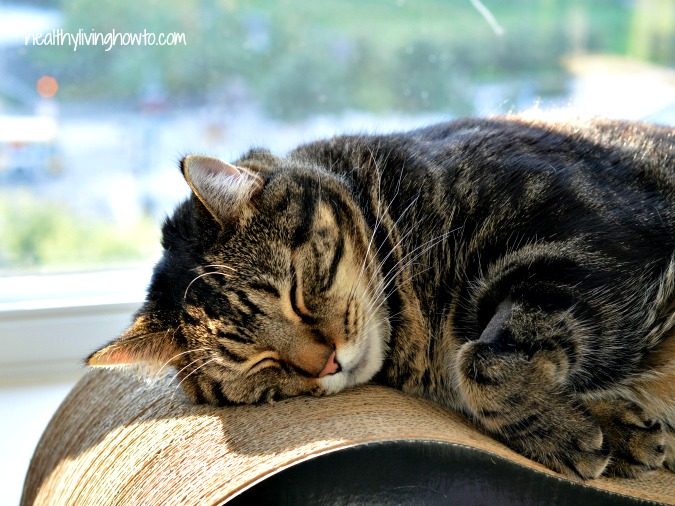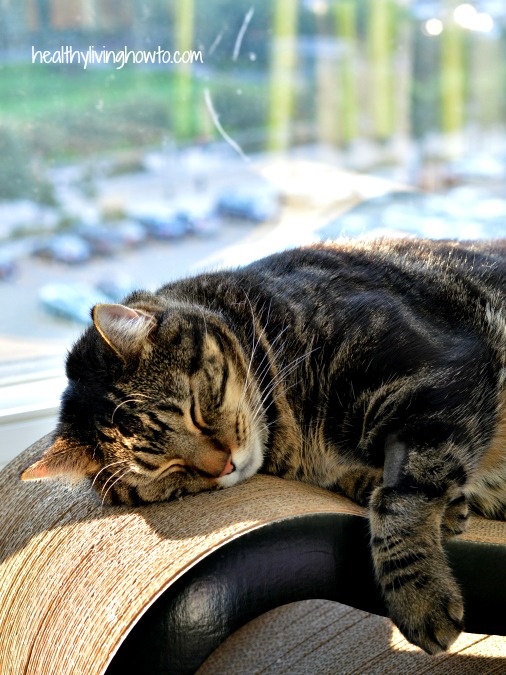If it's true that cats have nine lives, then our kitty Kirby, affectionately known as Krabby, has seven left.
He used up his first life after he mysteriously went missing for an afternoon, only to be found a few houses down. I had visions of him frolicking in the farmer's field behind our then home, scaring the geese and on the prowl for mice. I thought he was having so much fun being a hunter that he was happy to leave his domestic life behind. Apparently my imagination was much wilder than his and a happy reunion ensued.
Kirby's second life involved a little more drama. Instead of lounging on an adirondack chair, whiskers blowing in the breeze, he was caged in a very small cage, with a cone on his head and an IV in his poor pathethic shaved paw.
A few weeks back, I bought two small boquets of flowers from Trader Joe's. Some flowers in the boquet bloomed fast and then expired, but the white lilies took a little longer to show their beauty and impart their fragrance. After about a week, I rearranged the boquet, took out the dying flowers and spruced it up a bit with fresh water and trimmed stems. What was left was some filler greenery and four stems of lilies which were just beginning to open.
On Saturday morning, we woke up around our usual 5 o'clock hour and all four of us, Tom, Kirby, Gizmo and myself cuddled on the couch, laptops on laps and coffee mugs in hand. We probably lingered on the couch a good two hours then got up to get our day started. It was close to 9 am when I noticed Kirby sitting so pretty on our dining table, next to the flowers. I grabbed my camera to take a picture and noticed yellow pollen all over him.
Then it clicked. Lilies are TOXIC to cats.
I have been doing research on house plants for our new home — plants that are safe and non-toxic to pets. Lilies are toxic — POISONOUS — to cats. I took a quick scan of the flowers and found a petal that had been nibbled on.
I cleaned the pollen off Kirby the best I could, but it was in his mouth. He had been cleaning himself of the pollen. I consulted with Dr. Google to find even the smallest amount of ingestion can cause rapid kidney failure. I then called the nearest vet to ask what should be done and was told in a firm way — you must bring him in RIGHT NOW!
We rushed to the vet as fast as possible and discussed the scenario with him. The course of action was to induce vomiting, start IV fluids and attempt to flush the toxins out of his system and then test kidney function. Apparently, it can take 24 – 72 hours for the kidneys to shut down, so while the vet couldn't guarantee this would be successful, we had no other choice. Kirby was facing a minimal sentence of three days in the cage.
Krabby, I mean Kirby, was not too happy with his extended stay but in the end, he survived. His kidney function test was normal on Monday afternoon and we picked him up shortly before dinner. He has been extra affectionate since arriving back home, however, apparently, he lived up to his nickname well. I was informed more than once by the vet staff of his uncooperativeness.
I think he was just pissed they shaved his arm. Or maybe it was the fact the vet said he was obese and needs to go on a diet.
17 Common Poisonous Plants to Pets
1. Lilies
Members of the Lilium spp. are considered to be highly toxic to cats. While the poisonous component has not yet been identified, it is clear that with even ingestion of very small amounts of the plant, severe kidney damage could result.
2. Marijuana
Ingestion of Cannabis sativa by companion animals can result in depression of the central nervous system and incoordination, as well as vomiting, diarrhea, drooling, increased heart rate, and even seizures and coma.
3. Sago Palm
All parts of Cycas Revoluta are poisonous, but the seeds or “nuts” contain the largest amount of toxin. The ingestion of just one or two seeds can result in very serious effects, which include vomiting, diarrhea, depression, seizures and liver failure.
4. Tulip
The bulb portions of Tulipa/Narcissus spp. contain toxins that can cause intense gastrointestinal irritation, drooling, loss of appetite, depression of the central nervous system, convulsions and cardiac abnormalities.
5. Azalea/Rhododendron
Members of the Rhododenron spp. contain substances known as grayantoxins, which can produce vomiting, drooling, diarrhea, weakness and depression of the central nervous system in animals. Severe azalea poisoning could ultimately lead to coma and death from cardiovascular collapse.
6. Oleander
All parts of Nerium oleander are considered to be toxic, as they contain cardiac glycosides that have the potential to cause serious effects—including gastrointestinal tract irritation, abnormal heart function, hypothermia and even death.
7. Castor Bean
The poisonous principle in Ricinus communis is ricin, a highly toxic protein that can produce severe abdominal pain, drooling, vomiting, diarrhea, excessive thirst, weakness and loss of appetite. Severe cases of poisoning can result in dehydration, muscle twitching, tremors, seizures, coma and death.
8. Cyclamen
Cylamen species contain cyclamine, but the highest concentration of this toxic component is typically located in the root portion of the plant. If consumed, Cylamen can produce significant gastrointestinal irritation, including intense vomiting. Fatalities have also been reported in some cases.
9.Kalanchoe
This plant contains components that can produce gastrointestinal irritation, as well as those that are toxic to the heart, and can seriously affect cardiac rhythm and rate.
10. Yew
Taxus spp. contains a toxic component known as taxine, which causes central nervous system effects such as trembling, incoordination, and difficulty breathing. It can also cause significant gastrointestinal irritation and cardiac failure, which can result in death.
11. Amaryllis
Common garden plants popular around Easter, Amaryllis species contain toxins that can cause vomiting, depression, diarrhea, abdominal pain, hypersalivation, anorexia and tremors.
12. Autumn Crocus
Ingestion of Colchicum autumnale by pets can result in oral irritation, bloody vomiting, diarrhea, shock, multi-organ damage and bone marrow suppression.
13. Chrysanthemum
These popular blooms are part of the Compositae family, which contain pyrethrins that may produce gastrointestinal upset, including drooling, vomiting and diarrhea, if eaten. In certain cases depression and loss of coordination may also develop if enough of any part of the plant is consumed.
14. English Ivy
Also called branching ivy, glacier ivy, needlepoint ivy, sweetheart ivy and California ivy,Hedera helix contains triterpenoid saponins that, should pets ingest, can result in vomiting, abdominal pain, hypersalivation and diarrhea.
15. Peace Lily
Spathiphyllum contains calcium oxalate crystals that can cause oral irritation, excessive drooling, vomiting, difficulty in swallowing and intense burning and irritation of the mouth, lips and tongue in pets who ingest.
16. Pothos
Pothos (both Scindapsus and Epipremnum) belongs to the Araceae family. If chewed or ingested, this popular household plant can cause significant mechanical irritation and swelling of the oral tissues and other parts of the gastrointestinal tract.
17. Schefflera
Schefflera and Brassaia actinophylla contain calcium oxalate crystals that can cause oral irritation, excessive drooling, vomiting, difficulty in swallowing and intense burning and irritation of the mouth, lips and tongue in pets who ingest.
Source: ASPCA 17 Poisonous Plants
For a complete list: Toxic and Non-Toxic Plant Database
Look closely and you can see his missing fur.

